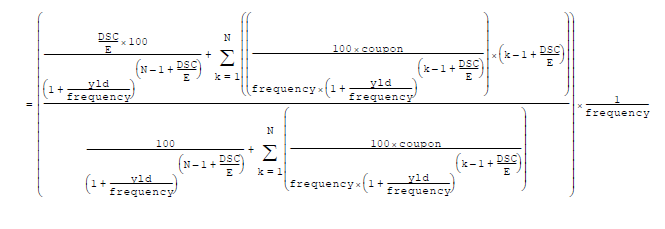MicroStrategy ONE
Duration
Returns the Macauley duration for an assumed par value of $100. Duration is the weighted average of the present value of the cash flows and is used as a measure of a bond price’s response to changes in yield. Bonds with higher durations face higher risk from changes in interest rates.
Syntax
Duration <Basis> (Settlement, Maturity, CouponRate, YieldRate, Frequency)
Where:
Settlement is the settlement date. This is the date, after issue, on which the security is traded.
Maturity is the maturity date. This is the date on which the security expires.
CouponRate is the annual interest rate of the coupon.
YieldRate is the annual yield.
Frequency is the number of coupon payments per year. The valid values are 1, 2, and 4 where annual payments =1, semiannual payments =2, and quarterly payments =4.
Basis is a parameter that indicates the time-count basis to be used. The default value for Basis is 0, which is typically used by American agencies and assumes 30-day months and 360-day years (30/360). Possible values for this parameter are listed in the following table.
| Basis value | Application |
|
0 (30/360) |
Assumes 30 days in each month, 360 days in each year. |
|
1 (actual/actual) |
Assumes actual number of days in each month, actual number of days in each year. |
|
2 (actual/360) |
Assumes actual number of days in each month, 360 days in each year. |
|
3 (actual/365) |
Assumes actual number of days in each month, 365 days in each year. |
|
4 (30/60) |
Used by European agencies, assumes the same values as “0” for American institutions. |
Expression

Where:
DSC is the number of days from settlement to next coupon date
E is the number of days in settlement’s coupon period
N is the number of coupons from settlement to maturity
Usage Notes
The Settlement date and the Maturity date should be included within single quotations in the expression for the expression to be considered as a valid expression.
